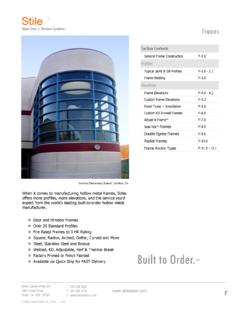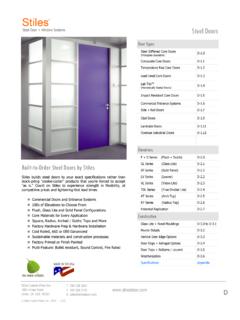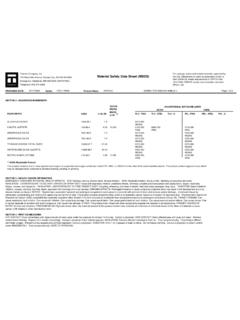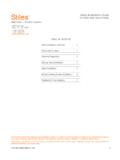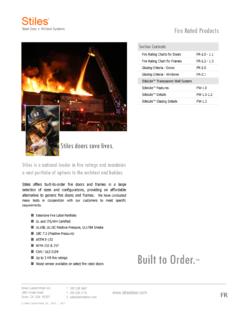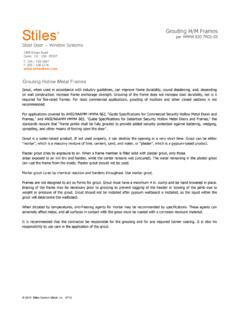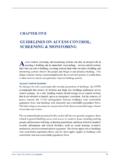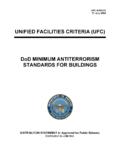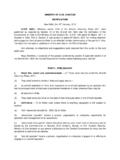Transcription of Security Glass and Glazing Guide 0710 - stilesdoors.com
1 This Guide has been prepared as a basic introduction to Security Glazing . It is by no means intended to be utilized for the interpretation of building codes, regulations, or statutes governing Security Glazing . Information contained herein is subject to change in accordance with manufacturer s product line updates as well as building industry regulations. For technical assistance, please contact us at: (209) 538-3667 Table of Contents Description Page Introduction to Security Glazing Products 1 - 2 Codes & Testing Requirements 3 Design Considerations 4 Security Glazing Requirements 5 Annealed Glass 6 Tempered Glass 7 Wire Glass 8 Heat & Chemically Strengthened Glass 9 Laminated Safety Glass 10 Burglar & Forced Entry Resistant Glass 11 Bullet Resistant All Glass Laminates 12 Acrylic 13 Polycarbonate 14 Bullet Resistant Glass Clad Polycarbonate 15 Return-Fire Composites 16 Security Laminate Films 17 UL 752 Ballistic Threat Level Chart 18 2010 Stiles Custom Metal, Inc.
2 0710 i Security Glass & Glazing Guide Stiles Steel Door + Window Systems 1885 Kinser Road Ceres CA USA 95307 T 209 / 538-3667 F 209 / 538-2776 Our technical manuals are prepared as tools designed to inform our customers of technical data as it relates to our products and services. It is our goal to help you make informed decisions when designing, specifying, ordering, installing, or maintaining Stiles products. Stiles makes no guarantee as to the accuracy of information obtained from outside sources. Whenever possible, links will be provided for additional information, and sources cited. Introduction to Security Glazing Products Threat Resistance, Types, Testing Requirements & Technical Considerations The use of Security Glazing products are world wide. In the United States, they are evident in such facilities as prisons, detention centers, research & development centers, communication centers, banks, law enforcement centers, hospitals, testing facilities, medical laboratories, industrial and chemical manufacturing plants, safe houses, safe rooms, armored vehicles and transports etc.
3 The continued use and growth, especially when it comes to the type of facility utilizing these products continues to expand and change. This is due to the expanding number of multinational corporations, government involvement s internationally, and the escalating need for Security related services. There isn t a sector in the business community that does not utilize some form of Security products or services. The 70 s and 80 s were two decades of technological breakthroughs for the Security industry. The 90 s has become a decade of finding the ways and means to interface those technological wonders and their multiple generation offspring into the real world. As physical Security is increased, so too does the threat. The ability to breech Security increases as more facilities harden themselves. The quickest growing breaching device being used today on a greater scale is the explosive device.
4 Bombs or explosive devices are more readily chosen, as they cause instant damage and injury. Couple this with two additional important elements such as: (1.) the fear factor, as bombs are easily constructed and planted, usually often undetected; and (2.) the fact that the bomber does not need to be present when it is detonated, making it the ideal weapon and/or breaching device while decreasing the likelihood of identification. In the United States the reported bombing incidents have soared by approximately 52% since 1990. The number of reported actual working bombs has also escalated from approximately in 5 to 4 out of every 5; either located or detonated. However, property damage and threats to window and door Glass units suffer the most from bombings, approximately 60 to 83% of the damages sustained from bombings is to the Glass . THREAT EXPOSURE There are three threats that need to be examined with regard to window Glass and Glazing systems.
5 These are: Forced Entry Attacks, Ballistic Attacks, Explosive Blast Attacks. Forced Entry Attacks are usually attributed to burglaries. Burglaries on a commercial scale can exceed millions of dollars, especially if the lost property is proprietary in nature or research & development advances. Forced entries can be of the smash and grab type to more sophisticated sustained assaults by multiple attackers with varied tools, times, and abilities. Forced entry attacks are of two types: The allowable entry or opening through which the stolen property or contraband may be passed, and an entry or opening of sufficient size to allow the quick passage of an entire body. Ballistic Attacks are solely attributed to assaults from either handguns, shotguns or rifles. Predominately handguns and shotguns. The severity of loss is enormous in two respects - loss of life and property damage. Injuries from ballistic attacks are related to two performance capabilities of the Glazing .
6 First, the ability of the Glazing to prevent total penetration of the impacting projectiles and the subsequent destruction and harm. And secondly, having the appropriate Glazing necessary to stop the impacting projectiles from penetrating, and not allowing excessive spall from the rear (protected) side of the Glass to impale those behind it. Injuries from facial lacerations to loss of vision to death have occurred from spall. 2010 Stiles Custom Metal, Inc. 0710 1 Security Glass & Glazing Guide Stiles Steel Door + Window Systems 1885 Kinser Road Ceres CA USA 95307 T 209 / 538-3667 F 209 / 538-2776 Explosive Blast Attacks are attributed to the deliberate or intentional acts of man. However, there are also industrial and chemical explosive blasts that occur from refineries, manufacturing plants, research & development facilities etc. There are four generalized damaging effects generated from explosive blasts: The primary cause, which is the shock or initial blast wave from the explosion.
7 The secondary cause of damage being the impact from fragments of the encasement material. Third, the hot gasses and flame that ignite fires, burn victims and its subsequent damage. The last cause is the ground vibrations or seismic loading caused effects similar to that produced by an earthquake. Before we examine Security Glazing in detail, a few elements relating to exposure need to be addressed. Glass by its nature is very fragile. It is that way because we want to see through it. Being fragile, Glass and Glazing products are totally unable to resist being cracked, broken, shattered and/or penetrated, depending upon its compositional make-up. Airborne Glass fragments propelled during failure of windows and doors subjected to explosive effects are known to be a major cause of injuries and death. Glass that fails to prevent the penetration of one or more projectiles during a drive-by shooting incident, is known to be another major cause of injuries and death.
8 Glass that fails to prevent unauthorized entry is a cause of property damage, theft, as well as injuries and/or death caused by the many violent activities associated with such criminal acts. These and other incidents can either be accidental or deliberate; terrorist bomb attacks, accidental chemical or industrial explosive blasts, workplace violence, earthquakes, hurricanes or gale force winds and their subsequent damage. Even more beleaguering to most businesses besides the total monetary losses which can be an attributing cause to spiraling insurance costs, is the negative publicity of a personal fatality or injury suit, which leads to reduced activity and ultimately income. As buildings are frequently being designed to have large expanses of Glass for aesthetic reasons, the risk to life from flying Glass fragments and penetration has become heightened and of greater concern.
9 Security Glass units are in the realm of physical Security measures a cost effective, continuous passive physical deterrent , which in most cases is undetected until attacked. Security and safety are important to owners, occupants and visitors of any building or facility. Today, all prudent designers and Security directors pay serious attention to the specific issues of Security and safety - especially to those issues which are most apparent to the users of the facilities. With respect to Safety and Security , the two are distinguished by the following definitions. SAFETY: Provides for the reduction of the risk or occurrence of injury, loss or death from accidental or natural causes. Security : Provides for the reduction of the risk or occurrence of injury, loss or death from the intentional actions of man. Security considerations pertaining to Glazing systems and components are determined by three factors: 1.
10 FUNCTION 2. AESTHETICS 3. AFFORDABILITY These factors are listed in the proper order as should be with any Life Safety product or component. 2010 Stiles Custom Metal, Inc. 0710 2 Codes and Testing Requirements Building codes in the United States only require that Glass units used in building structures be designed for Dead Loading . This specifically means - wind loads, snow loads and human impact loads. These vary from state to state and county to county as certain locations regulate variances from the standard Uniform Building Code. Glass is, however, not required by code: 1. To resist any burglary attempts - Forced Entry Resistance 2. To defeat projectile penetration - Ballistic Resistance 3. To defeat and maintain integrity from explosive effects - Blast Resistance These require independent testing laboratories test methods and standards that subject Glazing to these specialized classifications of attack.
